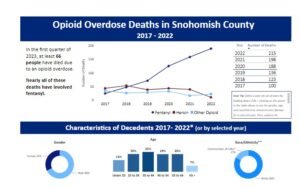
In March, Snohomish County Executive Dave Somers lost a younger brother to a fentanyl overdose. Photo Credit: Snohomish County
Also to boost education programs in schools and increase support for community organizations that provide support for those impacted by opioid use. Here’s more from a release issued by the Executive’s office.
Executive Dave Somers announced a set of overall goals and near-term strategies to address the impacts of the drug use crisis on Snohomish County. The goals and near-term strategies were developed in partnership with County departments, local elected officials, service providers, and emergency response partners as part of the Multi-Agency Coordination Group (MAC Group), an innovative approach to addressing the drug crisis.
In May 2023, Executive Somers issued an Executive Directive that reemphasized his commitment to an urgent, robust, and collaborative response to the drug crisis and established a new Disaster Policy Group. The Executive Directive set an aggressive timeline for developing and implementing strategies to address the drug use crisis:
- Within 30 days of the receipt of the Directive, the MAC Group must submit an updated list of goals to the Disaster Policy Group for consideration and approval;
- Within 90 days of the approval of new goals, the MAC Group must develop and submit to the Disaster Policy Group immediate strategies to reduce the number of drug-related deaths and mitigate impacts to property and public safety; and
- Within 180 days of the approval of new goals, the MAC Group must develop and submit to the Disaster Policy Group mid- to long-term strategies to reduce the number of individuals suffering from substance use disorder.

Click to see full chart of Opioid Overdose Deaths 2017 – 2022 from Snohomish Overdose Prevention website. (Click 2nd tab, takes a moment to load)
In response to the Executive Directive, the MAC Group – which includes representatives from Fire/EMS, housing and human services, public health and medical services, and public safety, among other key regional partners – developed a set of seven overall goals to guide the region’s response to the drug use crisis. These goals, approved by the Disaster Policy Group, focus on reducing and preventing instances of drug misuse, overdose, and death; expanding life-saving interventions and long-term treatment options; and increasing community awareness of available resources while reducing stigma. A full list of the goals is available here.
Per the terms of the Directive, the MAC Group then developed a set of immediate strategies that can be implemented more urgently and with existing financial resources to achieve the approved goals. These strategies, now approved by the Disaster Policy Group, are in addition to existing and ongoing work already being conducted by the County and partner agencies.
A key near-term strategy is to develop a Mobile Opioid Treatment Program (OTP) that would operate in high priority areas of the county. A Mobile OTP would administer safe, federally-approved medications in combination with substance use and behavioral health therapies. This will help vulnerable populations access treatment and recovery resources by meeting them where they are.
The County and partners will also work to implement more robust prevention education programs in partnership with local school districts and will engage with school leadership to identify locations and capacity to implement a pilot program. This initiative is critical as the number of opioid overdose deaths in Snohomish County more than doubled between 2017 and 2022, and at least 13 percent of those overdose death were among people under the age of 25. Between 2020 and 2022, at least 10 Snohomish County youth ages 11 to 17 died of an overdose, and 49 people between the ages of 18 and 24 died of an overdose, according to Washington State Department of Health data.
Additional near-term strategies include efforts to increase the availability of overdose antidotes like naloxone and administer $150,000 to community organizations that provide opioid support services in Snohomish County.
The full list of the near-term strategies is available here.
The MAC Group has developed those goals and near-term strategies along the timeline provided in the Directive and has begun implementation. In addition, the MAC Group is developing mid- to long-term strategies to submit to the Disaster Policy Group to reduce the number of individuals suffering from substance use disorder. These strategies will be wider in scope and will likely require additional state and federal resources.
Snohomish County is committed to providing education and overdose prevention efforts throughout the county. To learn more, find treatment resources, and/or request a naloxone training, visit this website.




September 1, 2023
Everett